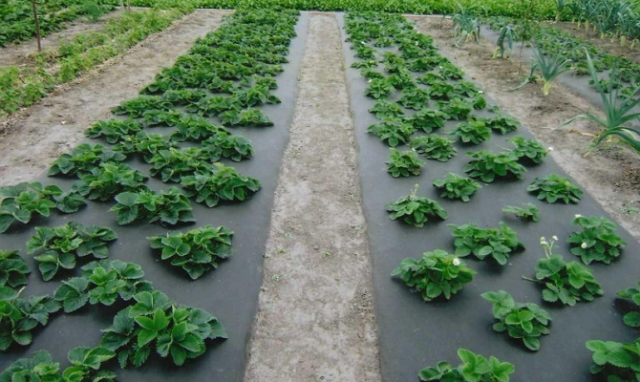Increasingly, gardeners when growing strawberries use agrofibre. Due to the use of the polymer material and its unique characteristics, the laboriousness of work on the beds has been significantly reduced. When choosing an early berry in the market, preference is given to pure strawberries with even color and no signs of decay. Such a crop can be grown with the use of agrofibre. In this article, we will learn what material is better for arvofibre, how to plant a berry under it and consider the planting pattern.
Table of contents
- What is agrofibre for strawberries and what is it for?
- Advantages and disadvantages of using agrofiber when planting strawberries
- Types of agrofibre
- When is it better to plant strawberries using agrofibre: in spring or autumn
- How to plant strawberries under agrofibre?
- How to water strawberries under agrofibre?
What is agrofibre for strawberries and what is it for?
Material began to use not so long ago (about 15-17 years), but its benefits have already been appreciated by millions of gardeners. The cloth is made of polypropylene fibers in the nonwoven way. The porous structure does not interfere with the penetration of moisture and oxygen. The composition does not include toxic substances, which indicates the safety of the product, both for human health and the environment.
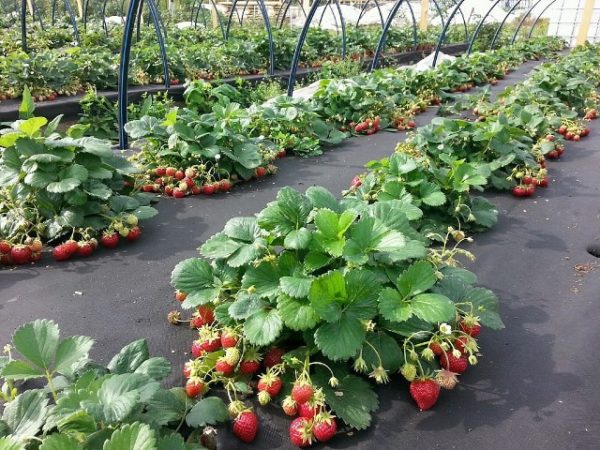
Agrofibre is intended for different directions of agricultural activity. The material protects sprouts from spring frosts on the soil, creates a microclimate comfortable for plants, and prevents the soil from drying out. Weeds do not grow on sheltered beds because of their opacity, and the thermal conductivity index makes it possible to warm the walls of greenhouses,operated year-round or from February.
Depending on the species, shelter can line the ground. or be fixed on the frame, closing the plants from the scorching sun or torrential rains. Textiles prevent damage to plants from strong winds or hail. The use of material for greenhouses makes it possible to get an early harvest. Unlike film, textiles freely allow air and moisture, and in the price it is quite affordable.
Previously, when growing strawberries to create a comfortable environment and protection had the method of mulching. On top of the soil in the beds sprinkled sand mixed with peat or littered with straw, dry leaves. Mandatory and regular were also considered: watering, loosening the soil, removing weeds. Using agrotextiles, you can reduce the time and effort to a minimum.
Advantages and disadvantages of using agrofiber when planting strawberries
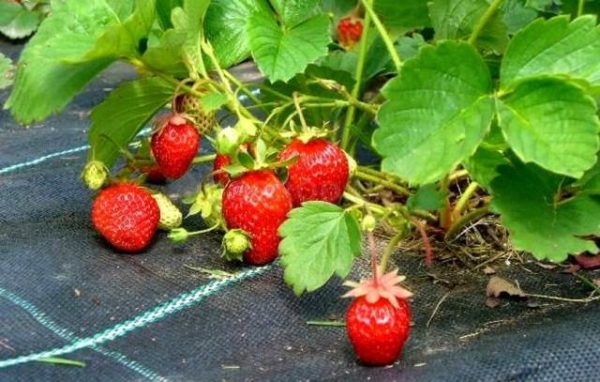
As any material, agrofibre has its advantages and disadvantages. You should be familiar with them so that there are no unpleasant surprises in the process of laying out or using.
The advantages of non-woven material include:
- simple and fast way of laying on the beds;
- the soil is protected from weathering and drying;
- after watering or raining the berries will remain clean;
- the lack of contact of strawberries with moist soil prevents the formation of rot or unripe areas;
- no rowing from weeds;
- control of mustache growth is much easier;
- reduced amount of watering;
- reduced risk of fungal infection;
- berries ripen 2-3 weeks earlier.
It is worth adding to the listed advantages that the material is used repeatedly. With careful handling, it retains its qualities for 3-4 years.
The material has a few minuses. The first time after the appearance of textiles on the market, its cost was inaccessible to the masses. Now this fact is irrelevant. Of the more significant drawbacks - surface contamination after rain or watering. You can solve problems by simply washing the canvas with soap and water. When purchasing a product, you should choose the right density.
With an indicator of more than 30 g / m2, there is a high probability of dew formation on the inner surface, which creates favorable conditions for the spread of various diseases.And one more minus is low strength, the web breaks under mechanical action.

Types of agrofibre
Depending on the density indicator, the purpose of the material and its type is determined.
- Textile 17 g / m2 is available in white and black, used as a shelter beds. It is used to protect crops or crops from frost (up to -2 °), rain, temperature difference, the spread of pests. Due to its light weight, the canvas is lined up directly on top of the plants, not hindering their development and growth. Light transmission capacity is up to 90%. It is not necessary to remove the agrofibre for irrigation, disclosure is provided only during the flowering period for the purpose of pollination.
- Textile 23 g / m2 is designed to protect crops from frost (from -2 ° to -5 °). When laying it does not require a frame, the canvas lies on top of the beds and is fixed with heavy objects around the perimeter. Also, this type is used for wall insulation greenhouses.
- Textiles 30 g / m2 protects from frost (up to -7 °), scorching sun, wind and heavy rain. The structure of the material is durable, able to withstand snow drifts.Cloths are fixed on the frame (often curved tubes) or trunks of shrubs and trees. This cultivation technology provides early harvest (2-3 weeks).
- Textile 42 g / m2 is a durable material that is used for greenhouses and greenhouses. Due to the properties and density of agrofibre, plants are protected from frost (down to -8 °), temperature changes and adverse weather conditions. Shelter greenhouses performed in advance (one week before planting or seeding) to warm up the soil and air. In the autumn, the trunks of bushes and trees are wrapped in cloth to protect them from freezing in winter.
- Textile 50 g / m2 does not transmit light, is used as mulch. It is laid on the ground, protecting the beds from weeds, drying out of the soil. Hibernation with such shelter prevents the freezing of crops.
- Textile 60 g / m2 white color represents the most dense and durable material used for greenhouses, greenhouses. Prevents freezing of plants at 10 degrees of frost. Well passes light and moisture, creating favorable conditions for development and growth.
- Textile 60 g / m2 black is designed for mulch, does not let light in, which prevents the growth of weeds. The material retains heat well, passes air, prevents the spread of mold.
Available in white and black agrofibre in rolls with a width range from 1.5 to 4.2 m.

For mulching strawberries suitable black cloth with a density of 50 g / m2. In difficult climatic conditions, it is recommended to use at the same time 2 types of textiles: white color 17 g / m2 for shelter over beds, black color 60 g / m2 for laying on the surface of the ground.
When is it better to plant strawberries using agrofibre: in spring or autumn
Strawberries are usually planted in both spring and autumn. When using agrofibre, it is preferable to do this in the spring, since all stages of the process are characteristic of spring garden works. Planted tubers grow faster and better, throw out antennae, which next year can increase the yield. And the canvas after wintering does not need to be removed in order to clean from debris and earth.
The landing period depends solely on the climatic conditions. In the middle lane, they do it from mid-April to early May.
How to plant strawberries under agrofibre?
Preparatory process
The first stage is settled beds. Choose a place on the plots for planting strawberries need to take into account the good illumination of sunlight and the availability of watering. If the garden is embossed, then preference is given to the upper tier, in order to protect the roots of the plant from excessive moisture of groundwater. Sloping beds should be leveled by making a reliable support to prevent the soil from falling off.

After marking the beds (taking into account the width of the agrofibre), digging and loosening of the soil is performed. At the same time it is necessary to remove old roots, garbage, weeds. The treated area must be fertilized. For these purposes, you can use humus, wood ash and other mineral fertilizers.
Next, the beds are lined with canvases, the joints are overlapped (at least 20 cm). Along the perimeter, textiles must be pressed down to the ground and secured with stones or bricks so that the wind does not tear the created shelter. Additional clamps are studs made of wire (Ø 6 mm). To do this, cut into pieces with a length of 70 cm, and bent in half. It is better to install them after planting the tubers, so it is easier to identify invisible zones (for example, between bushes).
How to plant a berry?
The next step is planting strawberries.Some manufacturers have taken care in advance, making holes on the canvas for seedlings. If there are none, then drop points are marked on the canvas. It is important to provide enough space between the bushes, but it should not be large either.
Ideally, there should be a distance of 20-30 cm between the holes. Scheduled places are cut with a sharp knife (the incision is made crosswise with a length of 10-14 cm). In the case of planting tubers with pots, it is recommended to make round holes for convenient installation and removal of the plant. The depth of the wells corresponds to the parameters of the pot.
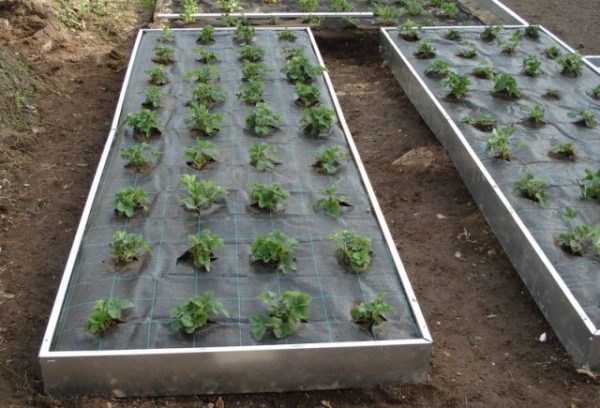
Planted tubers need to cover the corners of the notch and water well. It is better to do this with a hose with a sprayer installed. The rain effect will create less dirt on the canvas and ensure uniform wetting of the beds. In the period of engraftment of the seedlings on each bush, it is desirable to spend 0.5-1 l of water.
How to water strawberries under agrofibre?
Caring for strawberries grown under agrofibre, is carried out as usual. It is not necessary to remove the canvas for watering, the material is well permeable to water. One of the advantages of textiles - moisture retention in the upper layers of the soil. This is important to consider, so as not to overfill the beds. Regular mode of irrigation with sheltered ground is reduced by a third. Frequency depends entirely on weather conditions. In dry weather, it is recommended to moisten the beds at least 1 time in 5-7 days by sprinkling. Approximately 10 liters of water is used per m2 of land.
The stream from a hose should not be strong, it is necessary to use the nozzles dissecting water. Roots are located at the ground surface. At a plentiful pressure the soil will be washed away, having deprived tubers of shelter. The recommended water temperature for irrigation is at least 18 °. Cold irrigation can ruin a plant. The most commonly used settled liquid, in which the minimum content of chlorine and other chemical impurities.
Not less effective is a point watering. Such a system provides for the location of the hole on the hose directly at the root system of tubers. It is easier to track the amount of water consumed and the degree of wetting of the beds with this method.The only drawback is the lack of possibility of washing off dust and dirt from strawberry bushes.
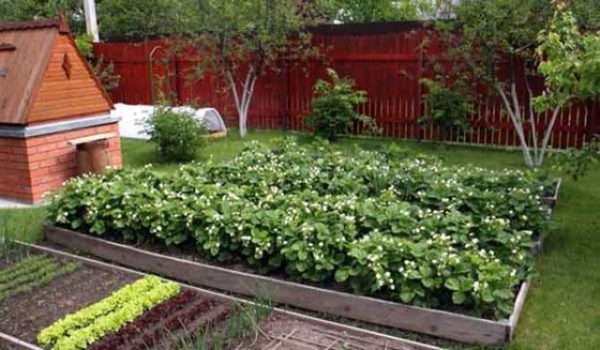
During the flowering period, watering increases to 3 liters per bush (up to 25 liters per m2). But the crucial point is the degree of soil moisture. If it is wet and loose, which is controlled by diverting the corners of the cut, then the amount of fluid is reduced. With reddening of berries in irrigation, the need is reduced, and sometimes irrigation stops for a while. So it will be possible to grow strawberries rich in flavors.
Before choosing agrofibre it is worth considering the important factors: purpose, period of use, bed parameters, climatic features. This will allow you to choose the most suitable option, providing early harvest and easy care. Now you know how to plant and cover your berry!
